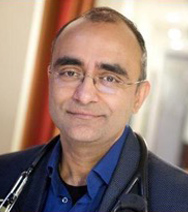
Cardiovascular Disease (CVD)
bh in BriefDr. Pandey is a Cardiologist and Assistant Clinical Professor (Adjunct) in the Department of Medicine at McMaster University. He is staff cardiologist at Cambridge Memorial Hospital in Cambridge and St. Mary’s Hospital in Kitchener, Ontario. Dr Pandey’s grandfather was an orphan born into poverty in India, and through the generosity of others was able to get an education. His son became a surgeon and immigrated to Canada. His grandson, in turn, also became a doctor and in recognition of the personal struggles and courage of his grandfather, who believed in giving back, started a family charity called Child2Child. Each summer, Dr Pandey leads a team of volunteers to do a month of volunteer work at Mother Theresa’s orphanage in Patna, India, near where his grandfather grew up. Their goal is to connect with individuals in need and make a difference in their lives: One child, one suffering Child2Child Mission
“… our nation and our world has been so good to us … It is time for us to | 1. What is CVD? What are the outcomes? CVD is a broad term that covers a range of diseases of the heart and circulatory system. The most common are atherosclerosis, heart attacks and strokes. CVD imposes an enormous disease burden and is responsible for a huge portion of morbidity in the western world where it is the number one or two cause of death across countries. Over time, a large subset of our population will have some form of CVD – as many as 65-70% of people. Although CVD takes many forms, in all cases, the disease process is identical and the same interventions reduce risks. 2. What are the interventions? Are they effective? The good news is that a staggering 90% of CVD can be prevented through modifications in five areas: cholesterol, smoking, diabetes, high blood pressure and abdominal obesity. We also have treatments that can control the disease when it is identified. The bad news is that we are not using the strategies we have. CVD events remain a leading cause of death and disease in Canada and elsewhere. Our Heart and Stroke Foundation estimates that every seven minutes a Canadian dies of heart disease or stroke. 3. What are the traditional treatments? Science has developed effective treatments. Overall, they reduce CVD events by about 30% but that still leaves 70% to be addressed. With respect to cholesterol, medications known as statins work well for most people but they don’t eliminate or cure CVD. There is also a need to reduce the occurrence of disease events in the subset of the population that still needs help to reduce cholesterol. The overall goal is to reduce the disease process, but one “cookie-cutter” approach will not work. Are there new therapies? New therapies are important for that small sub-set of individuals for whom traditional treatments have not proven to be effective and for those with a genetic condition (FH) that leads to aggressive and premature CVD unrelated to factors such as poor diet and lifestyle choices. These new, more aggressive therapies are only needed by those who have had a serious CV event or who have FH. Traditional therapies remain effective for the majority of patients. 4. How will new therapies influence the workplace? Effective interventions mean that employees can return to work faster, with fewer limitations and greater productivity. The new therapies mean that people who formerly faced significant risk of disability and even death will be more likely to return to their former productivity and full employment. Second, they can help employees prevent CVD by making healthy lifestyle choices available at work. By taking a broad approach to health promotion, they will also help prevent other health conditions like diabetes and depression. Third, they can motivate their employees. Recognizing the vital importance of using the tools and strategies science has given us to prevent and treat disease, they can empower others to take action. It is true that most CVD can be prevented and CVD event rates have gone down, but it is also true that the curve is no longer falling. It is incumbent on everyone – clinicians, insurance companies, employers and employees – to be hopeful and use advances in science to push forward the frontiers of possibility and wellness. bh |


